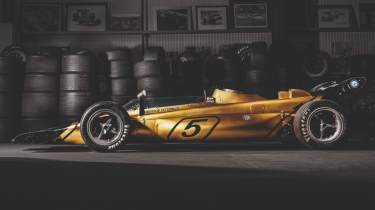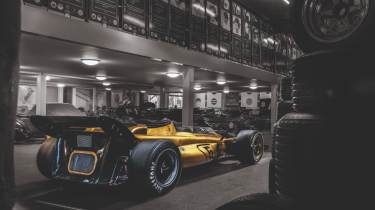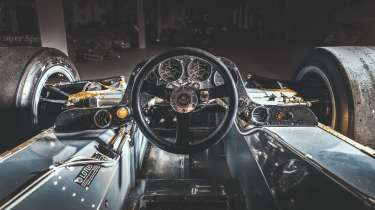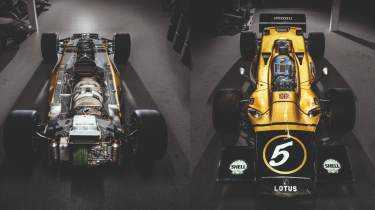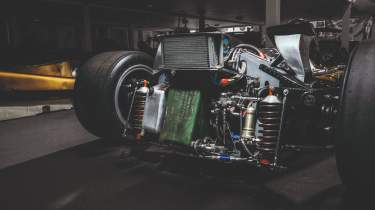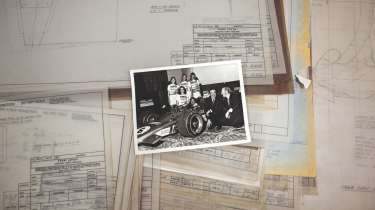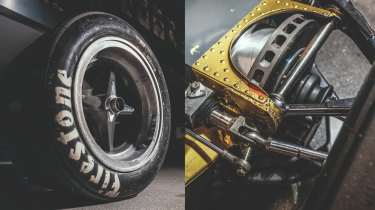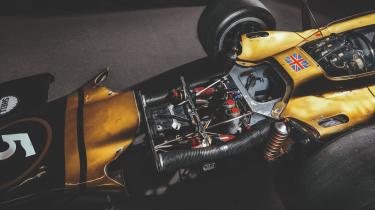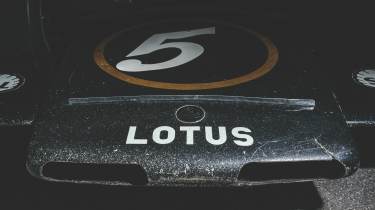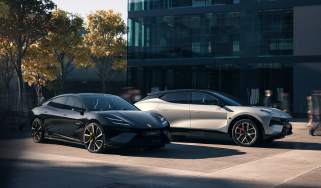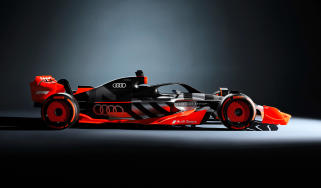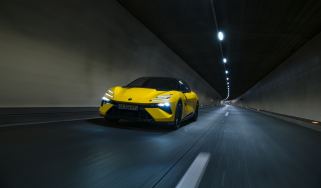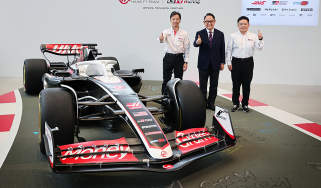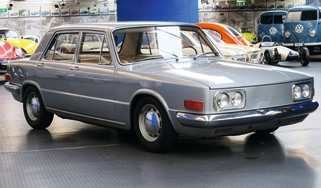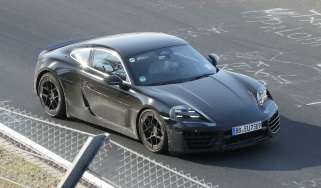Lotus Type 56B: the anatomy of a turbine-powered F1 car
Swapping Cosworth DFV for Pratt & Whitney, the turbine-powered Lotus Type 56B is one of the most radical F1 cars of all time
The lofty bravery levels of ’70s racing drivers are not generally disputed. But some things add extra context. I’m trying the Lotus Type 56B’s lay-down cockpit for size: next to my left elbow, hidden within the monocoque, is a propshaft that would be spinning at goodness-knows-how-many rpm; just behind my shoulders, a gas turbine engine limited to a casual 37,000rpm; and, back in the 56B’s short racing life, there would have been 350 litres of kerosene and petrol swimming around in side tanks to fuel it. I had to point my toes like a gymnast to post my feet under the front axle to the pedals. It’s tight in here, precisely packaged to the point of claustrophobia.
We’re stationary inside Classic Team Lotus HQ and the turbine is silent, sleeping, but a shiver still runs down my spine. Man, did they have some bottle. And weren’t they part of something remarkable too – what a unique, boundary-pushing creation to drive, and what a boundary-pushing, creative era to have been at the heart of.
Few teams pushed the creative boundaries like Team Lotus, of course. The 56B is the only gas turbine car to have competed in Formula 1, and the only one that ever will unless there’s a particularly radical rule change. In 2021 it ran again for the first time after an intensive restoration by Classic Team Lotus – pressing play on a moment frozen in time since it crossed the line in its last race, at Hockenheim in 1971, with Emerson Fittipaldi at the wheel.
Here on the upper floor of Classic Team Lotus’s purpose-built HQ, a stone’s throw from the Lotus Cars site at Hethel, we’re surrounded by a remarkable assemblage of cars, many of which are still run by the team for their owners in historic motorsport. It’s almost too much to take in. Here, Senna’s maiden Grand Prix-winning 97T; over there the outlawed twin-chassis Type 88; multiple Type 72s in glorious JPS livery; but none quite as singular as the 56B.
This is the story of the before, during and after of its short but fascinating racing life.
Gas turbine-powered cars gathered momentum in more ways than one in the ’60s. The fascinating Rover-BRM turbine car ran three times at Le Mans, and the pretty Howmet TX from America competed at Daytona, Le Mans and beyond later in the decade, but it was at Indianapolis that the technology really made its mark. Parnelli Jones very nearly won the 1967 Indy 500 in the STP Paxton turbine car entered by Andy Granatelli, head of the STP motor oil empire. Transmission bearing failure forced retirement from the lead with three laps to go.
Out for revenge on the racing gods, Granatelli commissioned Colin Chapman and Team Lotus to design a follow-up Indy challenger for ’68 and the Lotus 56 was born. Four cars were built for the race; tragically, driver Mike Spence was killed in a practice crash, but teammates Joe Leonard and Graham Hill qualified one-two and, again, Granatelli came within a handful of laps of victory only for fuel pump drive failure to scupper Leonard’s lead. For the following year, the technical regs were changed, inlet restrictions curbing power to render the turbine cars uncompetitive and effectively obsolete. The gateway to Gasoline Alley was closed. But there was still Formula 1…
With four-wheel-drive traction and a huge horsepower advantage over the Cosworth DFV-powered F1 cars of the time, Chapman could see the inherent potential in the 56, and at the start of 1970 the F1-evolution 56B was born, embarking on a season of testing before its ’71 race debut.
The 56B was a radical creation even by the standards of the design free-for-all ’60s and ’70s and the inventive minds of Chapman and his Team Lotus colleagues, including designers Maurice Philippe and Martin Waide. Its distinctive, lift-cheating wedge shape (aided by there being no need for a radiator) was wind tunnel-tested and one of the earliest aero-first racing car designs.
The chassis is an aluminium monocoque, with steel bulkheads for the engine and the suspension pick-up points, the bodywork predominantly glassfibre, with a huge one-piece mould for its upper surface, which lifts up and away from the car in one go. Today there’s fantastic original patina, carefully preserved rather than refinished: stress cracks in the upper bodywork, a mosaic of stone chips on the low-slung wedge nosecone, crackled paint on the bulkhead, which doubles as the dashboard and cockpit body mount. They’re a snapshot of the car as it was when it last crossed the line, and a marker of time’s passage since.
Bodywork removed, you can see glimpses of the original red/gold Gold Leaf tobacco livery beneath the gold/black colour scheme applied to the car later – an early trial for the JPS colour scheme, which was nearly black-on-gold rather than the iconic gold-on-black.
> Lotus Emira takes on Scotland – and retraces the steps of motorsport greats
Classic Team Lotus director Clive Chapman opens one of the broad drawers adjacent to the office’s entrance: within are the original drawings for the Type 56 and 56B. The wedge shape is the first thing that strikes you in Philippe’s elegant 1:10-scale packaging drawings; the second is the outline of that remarkable power source – one great cylindrical shape, taking up approximately the rear half of the wheelbase, and the driver the front half (minus their ankles)…
Heart of the 56B is a Pratt & Whitney turbine engine, derived from aviation. It’s a two-stage turbine: air is sucked into a big inlet ahead of the rear wing and fed into the combustion chamber via a compressor. A row of nozzles around its belly mark its gas stage, almost like a gas hob. Once ignited, that doesn’t stop until you cut the fuel. On tickover, the engine generates about 100bhp, meaning the driver must hold the car on the brakes to remain stationary (more on which later…).
What makes it a turbine engine as opposed to a jet is the presence of two rotors: the compressor turbine rotor, and the power turbine rotor. The exhaust gases flow out of a chimney just behind the driver’s head (period photos show one hell of a heat haze) while drive is taken via reduction gears to a chain-drive transfer box, and on to a Ferguson torque-splitter centre diff behind the driver’s left shoulder. Two propshafts run from there to the front and rear, down the left-hand side of the monocoque. The engine is offset to the right by two inches to accommodate them, balanced by the weight of the transmission. No gears to change: it’s twist and go. Or, release the brake pedal and go.
The instruments look more akin to an aircraft’s than a racing car’s. The two biggest dials are measured in per cent, showing the percentage of the engine’s capabilities in the gas section and power turbine sections (with taped-over no-go zones, to encourage the driver not to exceed 100 per cent). Plus, there are multiple gauges for pressures and temperatures. Idle temperature is around 450deg C; during racing it would get up to around 800deg.
Flared side-tanks were added to up capacity to 350 litres after the 56B ran out of fuel in an early race at Brands Hatch. Today it runs on Jet A-1 kerosene-based aviation fuel; in period, it ran on the aforementioned blend of kerosene and petrol.
Like the now-legendary Type 72 cars that Team Lotus was campaigning at the same time, the 56B featured inboard brakes to reduce unsprung mass – and to try to keep them cool. The most remarkable bit of preserved patina is the heat-blistered paint on the vents around the front brake discs. The calipers are huge: ‘You can trace the car’s development through the different calipers it ran,’ says Classic Team Lotus’s Lewis Cullington, who led the car’s restoration. ‘One, two, three, four iterations, getting bigger all the time, and the brake fluid pots get bigger and bigger because they would boil the fluid.’
The DFV in the back of the 72 was running ‘around 490bhp by then,’ Cullington continues. ‘This was running 650bhp, at 33,000 to 37,000rpm. What killed it was fuel consumption – twice that of a DFV – so it had to start the race with twice as much fuel, which meant it couldn’t use the 150bhp-plus advantage.’ (The 56B weighs around 680kg dry, before taking on all that fuel, compared with a 72’s tanked-up 600kg or so.)
Team Lotus ran the 56B in three world championship Grands Prix and several non-championship races through the 1971 season, as an experimental test bed alongside the 72s gunning for the title.
Wet weather was its perfect habitat, where its enormous traction could come to the fore. Its debut was the Race of Champions at Brands Hatch, where Fittipaldi was unbeatable in the wet practice sessions but uncompetitive in the dry race. Australian Dave Walker drove the 56B in the sodden Dutch Grand Prix, starting from the back of the grid before slicing through the field to reach the top 10 by lap 5, lapping faster than the leaders. One lap later, he was out, the 56B beached in the sand after sliding off under braking, much to the team’s consternation; a podium, or maybe even better, could perhaps have been on the cards for the turbine car – who knows?
Reine Wisell was behind the wheel for the British Grand Prix at Silverstone, but with the car significantly down on power it was 11 laps behind the race leaders when the chequered flag fell. Fittipaldi finished eighth in the Italian Grand Prix at Monza, and the car’s final outing was in an F5000 race at Hockenheim, Fittipaldi at the wheel once more. He was fastest in practice (in the wet), finishing second and setting fastest lap in the (dry) race.
‘For a race car in that era, there were a lot of problems to overcome,’ Cullington says. ‘Everything was mechanical then: air pressure sensors, all the other fine sensor controls.’ It’s interesting to imagine now, with modern software and materials, where the technology could theoretically go.
Pragmatically, rather than throw more resource at developing the 56B, Colin Chapman and Team Lotus decided to draw a line under the project and concentrate fully on refining the 72, on its way to becoming one of F1’s most dominant cars. Too specialised to be used for other purposes or cannibalised for spares, the 56B lay dormant in the Team Lotus storage buildings until nearly two decades into the next century, when Clive Chapman’s Classic Team Lotus operation decided to bring it back to life in time for its 50th birthday. ‘We restored 56/3 for its American owner and I got to demo it on an oval in LA,’ says Clive. ‘It was so exciting I resolved then and there that we had to get the 56B running.’
Lewis Cullington was lead mechanic for the 56B’s restoration, juggling the project with other Classic Team Lotus activities over three years. Lockdown put paid to most of the regular customer activities, and whilst not good for business, it freed up resources for a project like the 56B.
‘It’s one of the most original cars here, unchanged as far as possible from when Emerson did the last race,’ Lewis explains. ‘All the nuts and bolts are original as far as possible, only changed if anything was bent or worn, and essential changes for safety: the brake lines aren’t original, some of the steel components were rusting and we had to get a new rear driveshaft made.’
The biggest component replaced is, actually, the engine. ‘The original engine was toast, more or less. At the last race, they turned everything up, mixed in more kerosene and told Emerson: “Go for it.” That’s on display in a museum in America now.’
An equivalent engine had been sourced from the States but it was discovered to have been contaminated with grit. ‘At this point, after some bad luck, we got really lucky,’ says Clive. ‘Lewis started casting around for UK specialists and attracted the support of H+S Aviation. In particular their technician John Dawes became a godsend for us.’
‘Once we knew that we’d be okay engine-wise, we got into the rest of the car – then Covid hit, which actually freed up my time,’ says Lewis, recalling how the dedicated team kept working as much as possible through the pandemic.
One of the biggest challenges was sourcing a replacement transfer case – the original had been designed specifically for the car. Cullington had previously worked on restoring the 1968 Granatelli Lotus 56 IndyCar, and had that car’s case scanned with a view to being able to create a new one, challenging as that might be. Then the Team Lotus treasure trove of stores came good: ‘Clive and his son Arthur were in the archive, rummaging around for something and stumbled upon the original.’ Result!
‘What’s it like to work on? It’s a complicated car. To take a brake disc off, for example, the upright needs to come off, the shaft comes out, then the disc comes out… It’s not very mechanic-friendly,’ Lewis smiles. Nonetheless, you can see the pride and affection for the car when he speaks about it.
‘It’s been one of those projects for me – so different to do from a piston-engined car. I do feel proud; how many other people can say they’ve built a gas turbine F1 car? Maybe only the surviving people who were working on it at the time.’
Despite the myriad challenges, the team hit the target of the 2021 Goodwood Festival of Speed to celebrate the car’s anniversary. Clive Chapman’s son (and Colin Chapman’s grandson) Arthur piloted the car, as did the late and much-missed Simon Diffey, before Emerson Fittipaldi himself got in for a whoosh up the hill and down memory lane. Having witnessed it at first hand, it was a sight and sound like no other, both whistling past on the hill and warming up in the paddock, like a ground-level fighter jet.
Apart from the above, and in-period drivers Walker and Wisell, very few people have been behind the 56B’s wheel. Its last pilot was ex-F1 star Johnny Herbert, who drove the car at Monza together with other historic Team Lotus cars during the 2022 F1 weekend to mark the anniversary of its last world championship Grand Prix. He was a fan: ‘After his first run, he came back and said, “Right, no-one else is driving this: I love it!”’ Cullington recalls.
Clive has shaken the car down on the Hethel test track, and describes how it feels: ‘It’s quite intimidating when you’re standing next to it as it warms up; when you’re actually in the car it’s less so. It’s really quite pleasant to drive, and remarkably easy. I got up to about 170mph without trying…’ (Cullington tells me the current gear ratio is good for around 178mph flat-out, while the theoretical top speed is 220mph.)
‘Without even getting the throttle down, you get up to about 100mph on idle,’ Chapman continues (and adds that the idle speed was even higher back when the car was racing). ‘What makes a massive difference is if you apply some brake at the same time as the throttle, then take your foot off; you get all the acceleration, and bypass the lag.’
Back when Fittipaldi, Walker and Wisell were racing the car, they’d have got on the power while still braking, getting the turbine spinning into its powerband ready for the exit. With all that going on, and bearing in mind the lack of engine braking compared with a regular car, I can’t help but feel a pang of sympathy for Walker sliding off under braking in the rain at Zandvoort.
Without a wailing reciprocating piston-powered race engine, it sounds very different on-board too. ‘You can hear the springs rattling, and other noises you don’t normally hear,’ Clive Chapman reveals.
The drivers may have been courageous, but so too were the 56B’s designers and engineers: it might be remembered as a dead end in F1 history but in today’s era where all Grand Prix cars are virtually the same by dint of prescriptive regulations, and the difference is made by minute data analysis and maximum budget, this level of unbridled creativity is no longer an option in modern Formula 1.
To combat the challenges facing the environment and personal transport today, a little of the no-limits engineering thinking that created the 56B might be just what the world needs. In fact, the turbine engine might even play a small part in transport’s interim future, as a range-extender solution in hybrid vehicles – including Ariel’s wild Hipercar – which supplement battery power with a compact, petrol-fuelled range-extender turbine.
